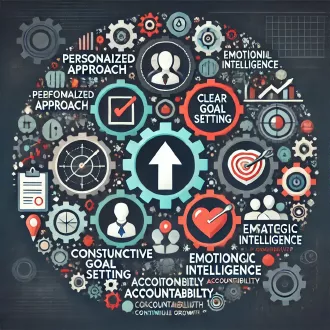Transcription Knowing the customer. Responsibilities with the customer
If your client is a sponsor or a superior looking to improve or develop specific aspects within the organization and you have been chosen to address these needs through leadership coaching, one issue emerges as an intriguing duality. The issue of accountability to your client and your coachee.
On the one hand, it seems simple, but it determines the ability to guide through troubled waters to firmer ground. The thinking you bring to the table could be the difference between shipwreck and success.
Therefore, you have to unravel relationships by asking the essential question:
- Who is my customer and what are my obligations and responsibilities to that entity?
In this journey towards understanding, it becomes crucial to establish a shared understanding from the very beginning of the client relationship. An understanding that stands as a protective shield against potential pitfalls and a foundation for building a strong and lasting relationship.
And how can we achieve this clarity if not through a set of questions that define the professional bond:
- Who should be a recipient of the information I share?
- Is it appropriate to share information only with certain individuals?
- How do I balance the need for confidentiality with the responsibility to report?
- What to do when priorities clash?
- How do I decide which priority deserves the lead in the race?
Whether you belong to the organization or have been hired as a consultant to do leadership coaching. Your compensation comes from that organization so you are accountable to someone else.
Let's imagine a scenario where leadership coaching is intertwined with organizational hierarchy. In this sphere, your position may vary, and therefore, the responsibilities. If you are coaching a team leader, your responsibility may extend to other team members, creating a mesh of interconnected relationships. However, you must know the boundaries and rules of this game: How far does your confidentiality extend? How much information can you share with different players on the board?
A challenge arises when you introduce this concept into this web. In this case, your client is not only the individual(s) under your tutelage, but also the team leader or manager who oversees their work. Or if you are a manager who has been assigned for example to train your colleagues. In this journey, the lines of confidentiality and communication must be delineated with surgical precision. Transparency is the key to opening doors to mutual understandings while protecting the integrity of your position.
You're likely to have reporting to do, as that senior manager wants to be kept informed and updated on progress. or lack thereof. And it's not as if you can refuse as it's a chain of responsibility.
It's best to opt for transparency and be as straightforward as possible from the start. For example by letting your coachees know that even if you have to share your observations with a superior, if they ask for discretion on a matter you will try to maintain confidentiality if possible, as long as it is not illegal or immoral.
It's about striking a balance between your duty to management and your duty to your coachees, to establish trust and give people time and leeway to solve their problems.
responsibility customer




